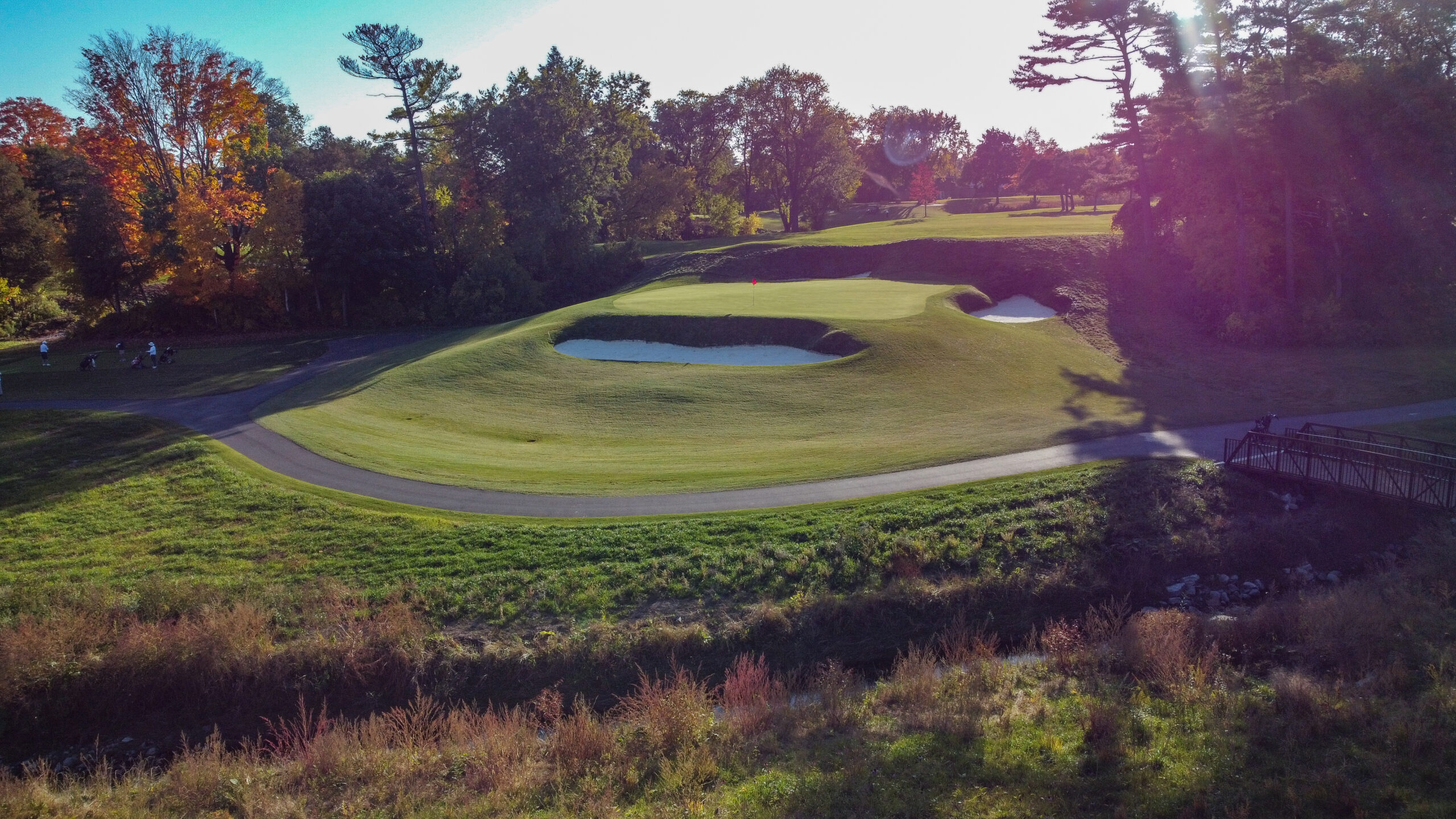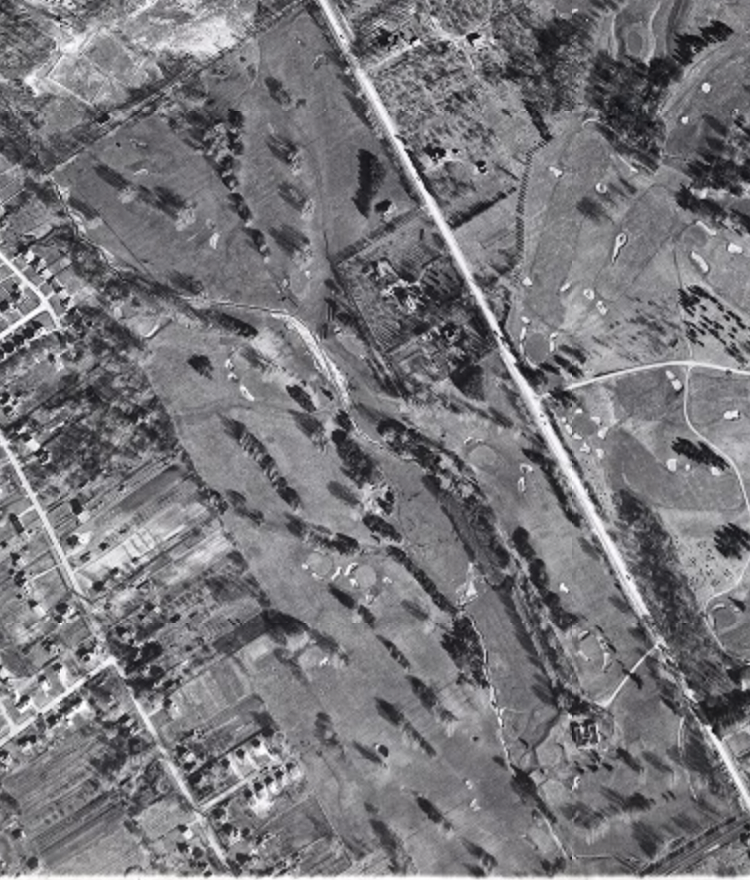A first-time visit to Lakeview in 2020 left me speechless. Being from out west, they do not make municipal golf like this (unless you live in Prince Albert, Saskatchewan, but that’s another discussion). The greens, with its varied tiers, rollicks, humps, bumps, and rolls were unlike anything else in the city, let alone municipal golf in Canada.
I was pleasantly surprised when I looked up the architecture pedigree, though I was not familiar with Herbert Strong’s work. In fact, to this day, Lakeview is the only golf course I have played from him—unless you count Manoir Richelieu, which Darrell Huxham took to the butcher shop and eviscerated the remains of Strong’s original golf courses there. What I do know, and Lakeview confirms, is Herbert Strong was a master green builder, with some of the most wild complexes in the city. In fact, my vote goes to Lakeview for the Greater Toronto Area’s most interesting set.
Lakeview was not always a municipal golf course, which makes a little more sense why Herbert Strong found his way to Mississauga in the 1920s. At its peak, Lakeview was a private club holding its own against Toronto Golf Club by reputation. Strong’s reputation must have been strong to go against H.S. Colt directly on the other side of the road roughly a decade after Toronto Golf Club opened. The 1923 and 1934 Canadian Opens came to Lakeview shortly after… I would say it was a success.
- Lakeview, 1956
- Lakeview, 2021
That version of Lakeview is a long time ago, however, and like every golf course, there was no escaping the Dark Ages from the ’50s to essentially the new millennia. Time took over, and Lakeview began to feel the wear and tear. Generally speaking, irrigation systems have roughly a 15-20 year lifespan. Bunkers are similar, and as time evolves, negligence slowly sees mowing lines creep inside to the point where greens and fairways are a shade of what they were.
I began to feel hopeful for Lakeview when rumours began to swirl about an upgrade forthcoming. Granted, the project started because of the City of Mississuaga’s Applewood Creek project to better preserve the creek. The aforementioned creek starts in the north end of the golf course next to the 16th tee, and winds itself down the duration of the par 5, 16th, left of the fairway on 12 and left of the 13th tee, through the 17th, up the right of 18 and left of 5, behind the 9th, left of 1 tee, and across the 8th hole. As part of that project, the creek was expanded and shifted to increase longevity and decrease erosion, meaning holes would be affected.
That’s where Cam Tyers comes in. An interesting choice for a project like this—a Jeff Mingay or Ian Andrew, restoration/renovation architects more established would be my first thought—but old the Doug Carrick associate got a chance at Lakeview to renovate the 16th and 17th is entirety, improve the green surrounds on the 5th, a new fairway on 18, and some new tees on the 1st, 6th, and 13th. In an era where city golf courses are under attack for some reason (here and here, for example), Mississauga did what no golf course east of Vancouver (Langara, Fraserview) has done: invest in their publicly-accessible and affordable golf.

To invest in municipal golf is to invest in a cities future; without community programs, fitness, and green space, a city is just a concrete jungle of nothingness. Luckily, golf checks all three of those.
There are lots of examples in the United States of successful “muni renovations” dramatically improving the golf course, and as a result, the community. Take Memorial Park, a struggling Houston golf course that Tom Doak renovated. Host of the Houston Open annually on the PGA TOUR, Memorial Park is $30 for adults to play on a weekday… $10 for juniors. As a result, of the TOUR playing the event at Memorial Park, $90 million in positive economic impact is felt throughout the community in the city. Prior to Memorial Park, the event was held in the community of Humble, Texas at The Golf Club of Houston.
Lakeview’s future is not a PGA TOUR event. Short on length and size, it is not an option. But a place like CommonGround in Denver is a place Lakeview can aspire to be. While not a municipal by definition, it serves the same purpose. Home of the Colorado Golf Asssociation, those registered in the state organization can play CommonGround for $52, juniors $20.
The poster child for all this municipal campaigning is Winter Park, a 9 hole course in the suburb of Orlando. A revitalized golf course from Riley Johns & Keith Rhebb is now the centrepiece of the community. 9 holes will cost you $20 to play a very thought-provoking and engaging layout, but the community putting course is free.
Memorial Park and Winter Park are not alone in such improvements. In fact, a quick scroll on Golf Magazine‘s 30 Best Municipal Golf Courses in the United States shows a trend of municipalities investing in their communities south of the border. Chambers Bay has a US Open under its belt, Butterfield Trail in El Paso is usually regarded as one of the better publicly accessible public facilities in the large state of Texas, Corica Park near Oakland is a thought-provoking layout in a great facility for the public, Keney Park is restored Devereux Emmet, Papago is home to Arizona State’s golf program, and the list goes on. Ever-growing, too, with facilities like Cobb’s Creek shaping up to be a successful endeavour.
Why is this important? Municipal golf courses are the entry point for golfers. Any argument about golf being expensive and exclusive do not apply to these types of facilities. This argument is rather tiresome anyway: of roughly 2,300 golf courses in Canada, only 230 of them are private, or 10% of the total facilities in Canada. Ironically, the war against golf is almost exclusively at municipal golf courses, where green fees are affordable, especially for juniors.
We can’t afford to have city run golf courses for a small privileged interest group. Clearly they influenced you which is sad. Those golf courses needed to be transformed into public park land and housing which is both desperately needed!
@andrew_urbanist
Terrible. We need more green space for everyone. Not some silly game for richer people.
@larcenyfresh
IMO golf is an incredible waste of urban green-space and not really inclusive at all for the general community
@waxmarmalade
The ironic part of Larency Fresh, or any of these Twitter uses targeting municipal golf, is they are going after Dentonia Park in Toronto, a $30.07 green fee and less for juniors. At Lakeview, $65.71 gets you 18 holes walking on a weekday. If we are generous with pace, let’s say that gets you 4 hours of entertainment. For comparison, the newly-popular Axe Throwing runs you at $30 per hour, per person in the city of Toronto, or $120 for the same amount of time. Granted, golf takes up acreage and people argue for the use of land to switch from golf to residential housing in Toronto’s housing crisis, but the benefits of having green space in the city (like a cooling effect), outdoor space for activity, fitness, and a communal gathering spot far outweigh the negatives in this case.

The way I see municipal golf courses is akin to public infrastructure like roads, or community centres. These amenities offered by the city must be kept, preserved, and maintained in order to make cities more livable and attractive. In order to keep Toronto, Mississauga, Calgary, Montreal, or anywhere else as a good place to live, we need to preserve features that enhance the resume of said cities. That includes municipal golf, which services a large group of the population (did you know 5.7 million Canadians play at least one round of golf per year?). If someone wants to target Beacon Hall, Rosedale, Shaughnessy, or any of the private clubs coast to coast, so be it: they will make a call based on what is best for the membership, and they can handle the heat. Though it would be a shame to lose any of those, private clubs generally have systems in place that benefit the members, and private clubs will always exist. It is the war on the defenseless —the municipal golf courses—that makes zero sense. Any attack on golf is generally met with criticisms of wealth and exclusivity, although municipal golf is the exact opposite.
The way I see municipal golf courses is akin to public infrastructure like roads, or community centres. These amenities offered by the city must be kept, preserved, and maintained in order to make cities more livable and attractive. In order to keep Toronto, Mississauga, Calgary, Montreal, or anywhere else as a good place to live, we need to preserve features that enhance the resume of said cities.
In order to keep golf as a physical activity people can enjoy with a community outside, cities must take note and invest in their facilities to better improve the lifespan going forward.

With Lakeview taking steps to improve their golf course, the general public can see thrilling architecture at the much-improved par 5, 16th, or even better, the par 3, 17th, a mere l00 yards to a terrifying green that Bryon Nelson once made 11 at. As Alex Hunter expanded on in his article for Beyond The Contour, the changes are an improvement, and as a result, that in itself is positive. Good golf architecture produces good golf courses, and as a result, those who play feel the gravity of such places. For anyone who plays Lakeview going forward, it becomes difficult to not feel the importance of the improvements from a pure golf course standard, and as a result, the imagination runs amok with “what would Lakeview look like if all 18 holes were like this?” Purely speculative, but judging off Winter Park, CommonGround, Memorial Park, or any other affordable option in major cities, golf becomes a keystone part of the community.
The point being, cities like Calgary, Toronto, and Montreal can learn a thing or two from what Mississauga and Cam Tyers have achieved there. To invest in municipal golf is to invest in a cities future; without community programs, fitness, and green space, a city is just a concrete jungle of nothingness. Luckily, golf checks all three of those. Don’t you want a nice place to live?












Learned to Play at Lakeview. Now play Riverside in Edmonton. Enjoy everytime I play Riverside & appreciate The City’s commitment to Victoria Park, Riverside, Millwoods; etc. in fact The City of Edmonton is to be complimented on its commitment to providing “Green Space” for all of its citizens to Enjoy!!
Thank you Edmonton!!